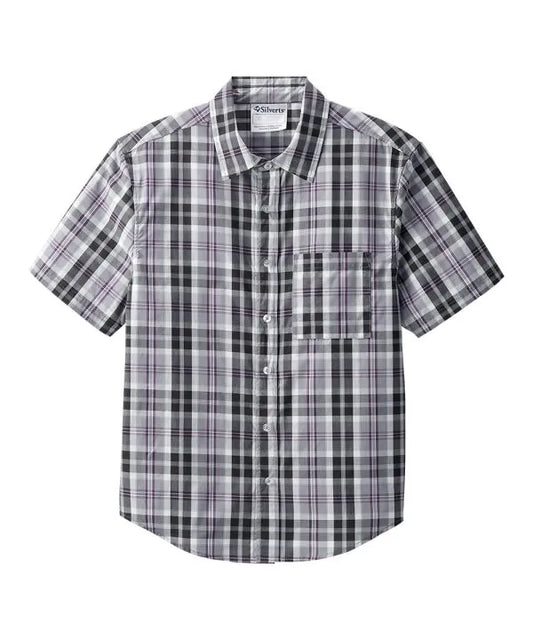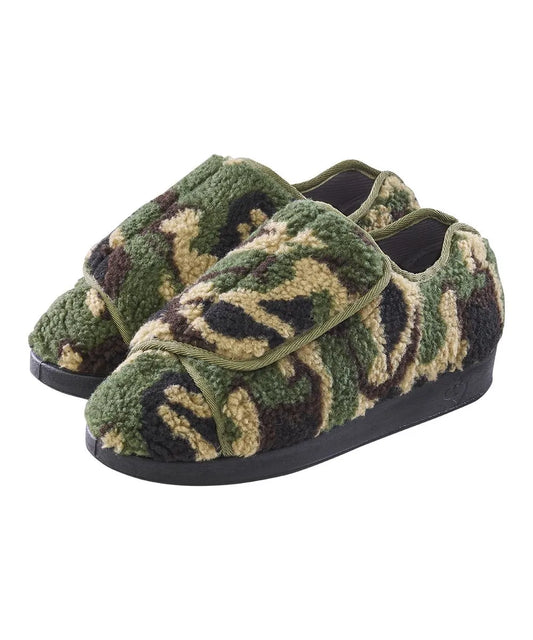Written by: Abdulmalik Al-Aghbari
Heat intolerance can turn dressing into an ordeal. Those navigating disability, illness, or healing discover certain clothes worsen discomfort - even causing pain via overheating. Luckily, clothing designed for ease of use is gaining ground, offering cool fabrics, practical cuts, alongside appealing styles tailored to those requirements.
Let’s look at great fabrics. We’ll give advice on clothes to stay comfortable, show off cool moisture-managing styles, present summer adaptive wear, and explain how to layer if you feel the heat. Also, discover choices from June Adaptive.
Which Fabrics Are Most Cooling?
People who run warm should begin by choosing the right materials. Certain fabrics breathe more easily, minimizing discomfort.
- For daily comfort, many people choose cotton because it feels light against the skin, lets air flow freely, and it's wonderfully gentle.
- For those bothered by irritation, bamboo feels wonderful against the skin - it lets air flow freely while being unlikely to cause reactions.
- Linen feels breezy - it lets air move through easily, making it ideal when the weather gets sticky.
- Certain fabrics, such as polyester or nylon mixes, for instance, work by drawing sweat off your skin, so you don’t get too warm.
If you rely on a wheelchair or sit a lot, clothes designed to move with you - using comfortable, stretchy materials - may keep you cooler while easing pressure on your skin.
These materials do more than just feel good; they each have special qualities for everyday life. Take cotton - it’s perfect for regular wear, though it holds onto sweat when you’re active. Combining it alongside fabrics that pull away moisture offers both coziness yet keeps you dry. For those with easily irritated skin, bamboo fabrics are a good choice - they don’t hold onto smells and feel cool, even when it’s sticky outside. Though linen wrinkles readily, it lets heat escape, so folks in warmer areas appreciate that quality.
Clothes built to manage sweat are showing up more often in designs that adapt to different needs. They’re particularly useful whether you’re doing a little activity, recovering from an injury, or simply spending time outside. These materials keep you feeling good by wicking away moisture. People using wheelchairs, or anyone sitting for long stretches, find they stay cooler - furthermore, their skin remains healthier because there’s less risk of chafing or painful bedsores.
How To Choose Clothing For Temperature Regulation
Clothes that help manage body heat aren’t simply a matter of material; how easily they’re used, alongside their construction, greatly impacts whether someone feels comfortable - or can get dressed on their own.
- Shirts fasten with magnets, zippers disappear, while Velcro offers easier wear - all designed to cut down on struggle and keep people comfortable.
- Clothes that aren’t tight let air circulate - this helps avoid skin irritation.
- Clothing designed for ease - for anyone facing limited movement or healing up - simplifies life, reducing everyday struggles.
The June Adaptive Mens Short Sleeve Shirt with Magnetic Buttons – a real help if regular fastenings are tricky. It’s crafted from airy material to keep you comfortable, combining usefulness with good looks.

What you wear to stay comfortable isn’t just about fabric - how clothes are built matters too. Details such as flexible waistbands, stretchy sections, or an open back boost airflow while letting you move freely. Folks using assistive devices, or dealing with swelling, really benefit from looser fits; constricting garments can worsen heat buildup alongside irritation.
Getting ready takes work, particularly when hands aren’t what they used to be. People dealing with stiff joints or difficulty moving might tire themselves out simply fastening clothes - even before activity begins, potentially causing them to feel too warm. Luckily, alternatives like magnetic fasteners or Velcro offer a simpler route, preserving strength alongside comfort.
Post-surgery garments should breathe easily, adjusting to changing needs. Because bodies are fragile after an operation, prone to getting too warm, keeping a stable temperature matters. Shirts alongside trousers built with gentle stitching yet airy materials provide ease during recovery.
Are There Stylish Moisture-Wicking Options?
Fashion now caters to everyone, not just those without limitations. It’s evolved - offering folks with disabilities comfortable, good-looking clothes featuring breathable fabrics so they feel their best.
- Comfy, capable activewear - ideal whether you’re gently getting back on your feet or enjoying a relaxed workout.
- Clothes designed for comfort skip rough seams - a real win for anyone whose skin gets easily bothered.
- Clothes built for moving - even when movement is tricky. They’re light, yet hold up well because the stitching is strong.
The June Adaptive Men's Collared Nightgown with Back Overlap - isn’t just for bedtime. Because it breathes well alongside its unique design, it feels good during warm weather, while recovering from illness, or following medical procedures. Moreover, individuals transitioning home from hospitals, or those needing clothes to aid stroke rehabilitation, find it especially useful.

These days, fabrics built to pull moisture away from skin aren’t just for workouts. Clever companies craft button-down shirts, golf shirts, even comfy clothes designed to handle perspiration - but they don’t sacrifice appearance. Consequently, individuals experiencing heat issues or living with disabilities can participate in events or work settings feeling confident, unconcerned about visible sweat.
Clothes designed to move with you feel better on the skin. They remove scratchy labels alongside harsh stitching - so they won’t chafe but will keep moisture at bay. This seemingly small change offers considerable relief if textures bother someone throughout their day.
Clothes built for activity now also look good out and about - a mix of usefulness alongside how they appear. That being so, folks can move directly from appointments to daily tasks without switching outfits. With fabrics that manage sweat, individuals often experience greater ease and belonging within general styles.
Best Summer Adaptive Clothing Lines
Hot summer days hit harder when moving around is difficult, or if you simply don’t handle heat well. Luckily, clothing made for everyone now focuses on cool materials, clever cuts, moreover looking good.
- Summer clothes for older adults focus on comfort. Think shirts that fasten with magnets, trousers featuring adaptable fits, moreover tops cut for simpler dressing.
- Clothes designed for everyone - people using wheelchairs, prosthetics, or needing a little help moving around - simply feel better whether sitting still or on the go.
- Comfortable clothes help folks feel good while bouncing back from operations - think soft fabrics, designs that don’t rub.
These June Adaptive Men's Soft Stretch Pants with Back Overlap design offer comfort because they move with you, go on effortlessly, also keep you cool. For people facing movement challenges - perhaps needing clothes designed around prosthetic limbs, or dealing with conditions like Parkinson’s - these offer real help. Because they barely weigh anything, they're also great for warm weather.

Warm-weather clothes now blend airiness with clever details. Think shirts fastening with magnets, trousers that easily adjust, likewise breezy backless tops – choices for anyone bothered by overheating. They particularly benefit older adults facing warmth combined with limited movement.
Clothing designed for everyone considers how things fit when someone is using a wheelchair. Think trousers cut to avoid awkward folds when sitting, tops that feel good - not tight or restrictive - with breathable materials keeping wearers cool throughout the day. These thoughtful touches mean comfort isn’t limited by how a person moves.
Recovering from an injury or operation? Summer clothes designed to adapt can help keep you comfortably cool while you heal, with less chance of getting overheated. Gentle, airy materials mean less rubbing on tender spots, which may speed things up because feeling better matters. These garments offer both comfort and a sense of self-respect, letting people look good even when they don’t feel their best.
Layering Tips For Heat-Sensitive Individuals
Despite mild weather, clothes should be worn in layers to stay comfortable. Those bothered by heat can do this while avoiding overheating.
- For comfort, begin with something that breathes - cotton or bamboo tees make good first layers.
- A shirt or vest with magnets? It means swapping layers is a breeze - no fussing around.
- For warmer days, a light cardigan - or perhaps a breezy linen jacket - offers a bit of shelter from the chill without weighing you down.
- Think about folks using wheelchairs. Fabric shouldn’t wrinkle or dig in when someone is sitting - comfort matters.
Clothing selections have a huge impact on people with disabilities - it's not only about aesthetics. Smartly designed clothes provide liberation, thus people can switch positions with the changing of seasons easily’, which means no matter what the situation is, dressing can be done comfortably.
Final Thoughts
Clothing that is in cooperation with you has a big influence on life, particularly when one is sensitive to heat. Breathable materials such as cotton, bamboo and even the advanced fabric that is made to whisk away sweat are the factors which are making a difference. It is about being comfortable, having options and being able to participate without suffering the consequences.
The easy-to-wear clothes gradually help people to be comfortable even with the temperature changes, not compromising the style or the function. Just think about a long sleeve shirt with magnet fastenings for the daily activities, a nightgown that is so well designed on the back that it is really cool to the wearer, or soft and cool stretch pants for the summer. This type of fashion is giving comfort and freedom to more people.
Adaptive clothing shows us how well being comfortable meshes with living on one’s own terms. It lets individuals navigate challenges - like heat - with assurance, showcasing personal flair instead of feeling restricted.
If you wish to read similar articles, do not hesitate to visit June Adaptive and sign up for the Newsletter below!















